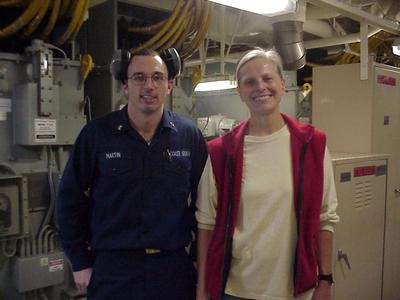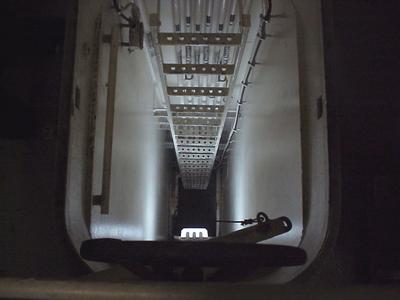22 August, 2002
First let me say that this is my 32nd wedding anniversary. Happy
anniversary, John!
My day started at 4:45 when I got up to do a second live audio transmission,
this time to Essex High School where all the district's teachers were
gathered for a pre-school in-service day. Jackie joined me after only one
and a half hours of sleep. Captain Visneski and Lee were there as well, and
we were all a bit tired, but it was fun to hear familiar voices and to begin
to visualize getting back to school!
Early in the cruise, I met ET (Electronics Technician) Second Class Chris
Martin who just happens to come from Swanton, VT, a town not far from where
I live. At first we went through the list of those people we knew in
common, but lately we've been sharing stories of the heat and humidity at
home. We're both glad to be here where we can layer our clothing and get
warm! Chris has been in the Coast Guard for nearly six years, and he's been
on the Healy for fourteen months. He volunteered to take me on a tour of
the areas of the ship where he works. This ship continues to amaze me with
its size and complexity! We climbed up and down into areas of the ship that
I knew were there but had never seen before. I'll highlight just a few of
our stops.
We started in the Forward Deck Machinery Room where we saw the AOPS (Air
Operated Pumps), which are used to keep water flowing to the incubators on
the bow. You might remember that two of the zooplankton teams as well as
the optics team are using incubators for their experiments. The water, of
course, must be available continually and it must be kept at just the right
temperature if the experiments are to work properly. The water comes from a
96,000-gallon tank of ballast water that must be filled at each station. As
this was a reasonably large space, it also contained a set of drums right
next to a rack of dry suits, which are available in case of flooding. It
was an odd combination! After passing by the armory where small arms and
the bear rifle are kept, we moved toward the bow thruster. The bow thruster
is a huge tube that splits and exits on both sides of the ship at the bow.
When needed, it pumps out 360,000 gallons of water/minute in order to
position the ship. It can be used for mooring or docking the ship, but we
hear it mostly when we are on station. That's when it is critical to keep
the ship stationary or in the correct position for the deployment of
equipment.
Water of all types is a big concern for a ship this size with this many
people on board. We saw the gray water tanks that contain used water from
showers, sinks, etc. and we saw the black water tanks that contain the
sewage, which is dumped overboard when we are moving. At a few of the long
stations (more than 24 hours), Jim and I would be sieving our last samples
on deck when the ship started to move. We always knew when the sewage was
going overboard! We also saw the two potable (drinkable) water tanks that
hold approximately 28,000 gallons of water. The water is obtained by a
"flash steam system." Seawater is first filtered to remove any organisms in
the water, and then it's heated and cooled to provide fresh water.
We climbed up and down many sets of straight up and down stairs, but we only
looked down the longest set, which led to the Transducer Well. The stairs
lead to the area of the ship where there is a sound transparent "window"
through the hull. All instruments that map the bottom and the ocean
currents are located here where they utilize the window. Our last stops
were the eight AMR's (Auxiliary Machinery Rooms). All the equipment that
keeps the engines running (i.e. fuel oil purifier, heat exchange, fuel
pumps) is located in these areas.
Science-wise, everyone seemed to be wrapping up his or her work today.
People were running their last sets of samples or sorting and preserving
their last organisms. Jim and I sieved the last two respiration cores from
Jackie's final experiment. All around us, people were packing up their gear
to be sent home or to remain on board until the ship returns to Seattle. I
was in the hold putting mailing labels on boxes when they piped the
announcement that there were whales surrounding the ship. Everyone rushed
out on deck to watch the gray whales all around us. They were spouting and
diving, and it was fun to try to figure out where the next one would
surface. At one point, I noticed two unusual birds flying overhead. They
were puffins although I couldn't tell which species. Tomorrow I'll tell you
a bit more about the gray whales when I write about some of the implications
of global climate change.

<> ET (Electrronics Technician) Second Class Chris Martin is from Swanton, Vermont, not far from where I live. He took me on a tour of areas of the ship where he works.

<> We climbed down many ladders although none as long as this one in the transducer well. This leads to the area of the ship where there is a special sound transparent "window" for instruments which map the bottom and the ocean currents.

<> Touring the ship with Chris was great exercise as we went up and down lots of ladders.

<> When needed, the bow thruster sends water out of the ship on either side of the bow at the rate of 360,000 gallons/minute in order to position the ship.
Contact the TEA in the field at
.
If you cannot connect through your browser, copy the
TEA's e-mail address in the "To:" line of
your favorite e-mail package.
|
